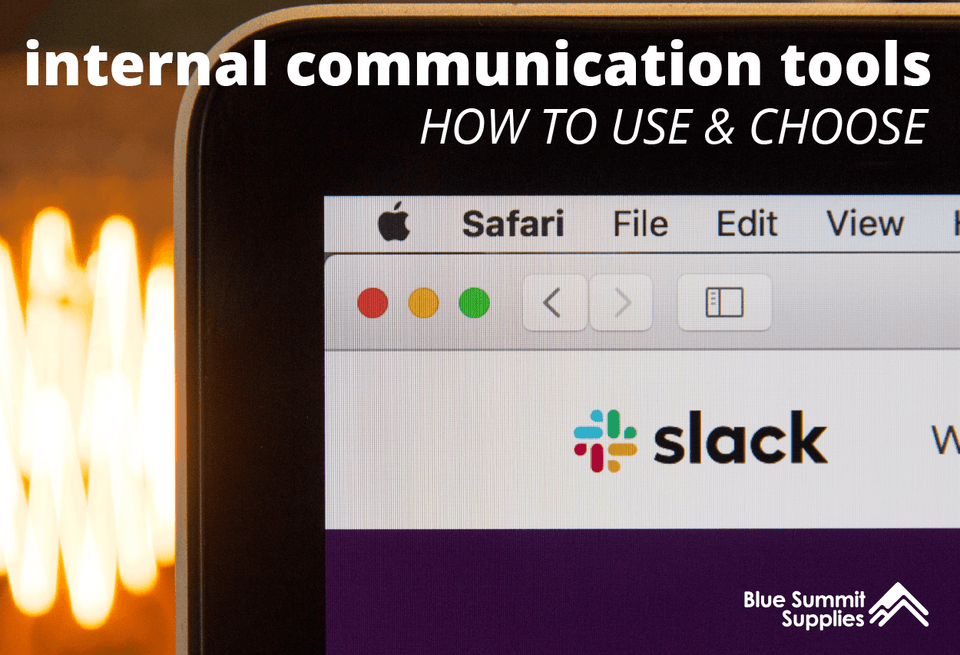Internal communication tools play a key role in maintaining effective communication across a company and within business teams. They provide a way for teams to communicate inside and outside of the office while aiding productivity, motivation, and team morale.
With so many platforms, apps, and software to choose from, how do you decide which internal communications tools are right for your business? In this post, we’ll discuss the importance of interoffice communication, how to choose the communication tools that are right for you, and how to use them effectively within your organization.

What is Internal Communication?
Internal communication includes every interaction and connection made between employees, management, and teams within an organization; it’s how individuals communicate with one another inside and outside of the workplace.
A business can’t run smoothly without effective communication. Simple miscommunications or misunderstandings can lead to reduced productivity and trust, and in the worst cases, interoffice conflict.
Internal communication platforms are the tools that keep an office running. They act as a messaging system so employees can communicate, deliberate, and socialize without needing to be in the same physical space. Depending on the platform you choose, they allow teams to share files, chat one-on-one, communicate as a group, host video meetings, and more. Many interoffice communication tools are designed to integrate seamlessly with your preexisting productivity tools.
The Importance of Interoffice Communication
Effective Communication
Communication can make or break a team. Teams that don’t effectively communicate are more likely to encounter misunderstandings and conflict. No matter what the size of your office, it’s critical that communication is prioritized. Without effective communication, a number of interoffice problems can arise, including lack of trust, reduced enthusiasm, and low motivation.
Increased Productivity
Productivity is the result of all office systems running smoothly—and they can’t do that without effective communication. When communication is prioritized, your team will be more productive because members understand and trust each other.
Projects can move forward without delay as your team won’t be distracted by the kind of tension and conflict that can cause roadblocks. An investment in interoffice communication tools is an investment in your bottom line since productivity improves the more effectively a team is able to communicate.
Collaborate Remotely
Communication is more important than ever as businesses move online and allow employees to work from home. When there’s no central office, communication tools fill that void by aiding all forms of communication from meetings to project check-ins to watercooler conversation.
Remote teams rely on communication tools for team building and maintaining an office culture without a real office. Even if your team is only partially remote, online communication tools can keep your business running smoothly if an employee is sick, needs to stay at home, or is on a business trip.

Do you work from home? Read our article on How to Work From Home With Children, Pets, and Other Distractions or our guide on how to Temporarily Convert to a Home Office.
Internal Communication Tools
Choosing the interoffice communication tool that’s right for your business depends on the size of your team and how much of your communication will occur online. If all of your meetings will be virtual, you’ll need a communication platform that can manage video conferencing calls for your entire team. To get everything you require, you may need to pair multiple tools.
Slack
Slack is the communication tool that we use at Blue Summit. It’s a chat-based workspace where team members can communicate in groups large and small or just one on one, tag each other, make calls, share files, and connect with other apps. Slack allows you to create a bunch of different channels devoted to one department, project, or theme, or you can message the entire office at once.
We chose Slack because it works best for our small business. The free version does everything we need it to, and it integrates with our other favorite apps . Free Slack saves the most recent 10,000 messages but deletes anything beyond that, and it only allows for one-on-one calls. To enable video conferencing, we recommend pairing Slack with Zoom.
Slack’s Standard package and Slack’s Plus package are available for a monthly fee. The paid packages save your entire message history and allow for a maximum of 15 participants on calls.
Features:
- Customizable communication channels
- Voice calls
- Searchable history
- 2,000+ app integrations
Microsoft Teams
Microsoft Teams is a cloud-based communication workspace that comes with a Microsoft 365 Business Basic or Standard subscription. Just like Slack, it has workplace chat, calls, and file sharing, but it also has file storage, screen sharing, video conferencing for up to 10,000 people, and it’s designed to integrate perfectly with other Microsoft apps like Word, Excel, OneDrive, SharePoint, and many other Microsoft offerings.
Microsoft Teams is ideal for businesses that need to host large conference calls. It’s generally the best choice for offices that are already embedded in Microsoft tools such as Word, Excel, SharePoint, or OneNote.
Features:
- Searchable history
- Up to 10,000 people for video conferencing
- File sharing
- Screen sharing
- Live collaboration
- Microsoft integrations
Zoom
Zoom allows you to connect with your team via HD video and audio using any device. It’s a cloud-based platform that makes it easy to host a virtual meeting or conference call or hold an online webinar or training session. Zoom has a free version that can host up to 100 people for up to 40 minutes. For longer video conference calls and the ability to host more people, there’s a paid version of Zoom available.
Features:
- HD Video conferencing
- Searchable transcripts (automatically generated)
- File sharing
- Up to 1,000 people for video conferencing
Other Business Communication Tools

Yammer
Yammer is an enterprise social networking platform that comes with a Microsoft 365 subscription. It’s where you can make company-wide announcements or updates, and it allows conversations with up to 80,000 members at a time.

Skype
Skype is a telecommunications application. It has voice calls as well as video calling for up to 50 people between computers, tablets, phones, and smartwatches, and it comes with call recording, screen sharing, and live subtitles. Skype for Business will soon be phased out and replaced with Microsoft Teams.
Workplace Communication Tips
Respect Other People’s Time
With online communication tools, it only takes a few clicks to reach any teammate you want. You can message, send a question, or start a video call all within seconds, no matter where you’re located. That said, just because you cancontact anyone at any moment, it doesn’t mean you necessarily should. Be respectful of other people’s time and availability. In a real office, you may be able to close the door, but communication tools are always open.
If you have a problem, always try to solve it yourself first. Could you find the answer to your question with a Google search? Can it wait until the next meeting? If your comment or question can wait, consider making a list of questions that you can address all at once rather than messaging that person every time something comes to mind.
Manage Work Chat App Notifications
Whether it’s from a phone call, social media notification, or Slack message, every distraction has consequences. When you are interrupted, even if it’s only to answer a quick question, it can take many minutes to regain your focus and get back on track again.
If you are constantly receiving and answering notifications, you’ll never be able to obtain deep focus. Ensure you manage your communication tool notification preferences so that you aren’t being interrupted throughout your entire workday.
Set Business Communication Hours
If you don’t need to be on call at all times to do your work, don’t be on call. Set your availability, leaving time aside for productive bursts of distraction-free work.
This will help you accomplish more in a day since you aren’t constantly jumping back and forth between working and communicating. It will also make clear to everyone you work with when you’re available and when you’re not so that they can plan accordingly.
More from Blue Summit Supplies
💡 How to Make Office Friends and Get Along with Coworkers
💡 Organizational Fit: The Importance of Culture Hiring
Do you love office talk as much as we do? Follow our office supplies blog for the latest trends, office strategies, product comparisons, and more.
If you have any questions or want to talk to someone about office supplies, send us an email or connect with us on Twitter, Facebook, or Instagram.
 For more informative articles about office supplies, subscribe to our email newsletter!
For more informative articles about office supplies, subscribe to our email newsletter!
Never fear, you won't begin receiving daily sales emails that belong in a spam folder. Instead, we promise a fun weekly roundup of our latest blog posts and great finds from across the web. And if you lose interest, it's always easy to unsubscribe with a single click.









